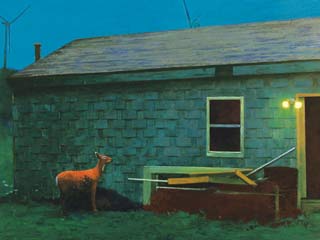Three painters, one family, at Meibohm Fine Arts
by Gerald Mead
The Daly Show

Meibohm Fine Arts in East Aurora has a history that dates to 1901, and since 1965 it has presented exhibitions of (mostly) regional artists’ work. It recent years, under its third generation owner Grace Meibohm, assiduously chosen solo exhibitions have featured such well respected painters as Catherine Parker, Joseph Orffeo, and Charles Clough, and works from the estates of artists such as James Kuo, Catherine Koenig, and Agnes Robertson. A short 20-minute countryside drive from Buffalo, I assure you it is worth the trip, and it mildly astounds me that this fine venue is frequently under the art radar.
The current exhibition is unique in concept in that it consists of work by a family of painters, Thomas Aquinas Daly, his wife Christine, and their son Jonathan. Accordingly, it provides a rare opportunity to see multiple artists’ response to a shared environment (the Dalys live, and Jonathan grew up, on a large farm in rural Wyoming County) and the many subtle, and often not so subtle, differences between their approaches.

Thomas is nationally renowned for his realist landscapes, still lives, and wildlife paintings, and as an avid hunter and fly fisherman; those environs serve as the inspiration for most of his watercolors and oils. You quickly become aware of the alluringly ambiguous quality of light in his works. This oddly specific and tenderly rendered light—often dawn or twilight—takes center stage in nearly every landscape and contributes to their appeal. There is something mystic about a time of day that is seen by so few, and by including a small solitary figure fishing or hunting in the scene, Thomas heightens the sacred nature of these unspoiled natural locales, places he describes as “adhering to their own quiet and eternal laws.” This effect is perhaps best personified in Snow Goose Hunters, with its luminescent shards of sky reflected in marshland pools of water.
Thomas is also much admired for his watercolors done in the tradition of game paintings, a genre of still life painting popularized by 17th-century Dutch artists that depicted the fruits of the hunt such as poultry, duck, rabbits or fish. This exhibition includes two exquisite works in this vein: Two Pike and A Snowflake. A third, Fish Decoys and a Salted Minnow, wryly reflects on the genre, as two of the three fish it depicts are in reality carved wooden fish, the tools of the trade of a seasoned fisherman.
Christine’s works in this exhibition are primarily diminutively scaled still-life oil paintings. These works, without exception, reveal the artist’s virtuosity as a draftsman, but more importantly, her ability to use composition as a tool to evoke a poetic sense of balance and repose. The objects she selects are commonplace—a cup, a vase with just a few flowers, some fruit—however it is the placement of the objects and overall arrangements that show her editorial prowess. A Red Lily illustrates this point well. In this work, a short-stemmed red day lily rests atop a worn porcelain cup. The deftly rendered, shadowed silhouettes that both forms cast on each other and their spare background activate the stark composition. The effect is decidedly elegant—a study in the power of visual restraint that takes advantage of states of tension that can exist between object and surface.

Rounding out the exhibition is the work of Jonathan Daly, who recently completed his MFA at Boston University. His subject matter is more varied, focusing on country scenes, still lives, and portraits, but it is in the still lives that we can see how the artist has merged his rural roots with what he refers to as a “modern synthetic environment.” Often, this is expressed in the objects that he chooses to paint. For example, the oil painting Arrangement with Packaged Feather includes a single feather encased in a plastic sleeve—a commodified natural object that is destined to be recontexualized in a craft project. It is simultaneously natural and unnatural. In Bliss Garage, he chooses not to edit out the wind turbines on the horizon that proliferate in rural landscapes, and the deer standing alongside the structure is in reality a plastic deer decoy (an object that is marketed to hunters as the “icing for your deer hunting cake!”). Finally, Jonathan’s use of color—a bright blue or blue/green often appears for emphasis—boldly contrasts with the more subdued palette prevalent in his parents’ work.
A wall in the last gallery, a grouping of still lives by each of three artists, offers an ideal opportunity to compare and contrast the three artists’ work and affirms the logic behind showing them together. Viewing these works in close proximity allows one to examine a common thread between them—the distinctive textural surfaces each artist paints as backgrounds for their compositions. It’s a rewarding end to an exemplary exhibition.
blog comments powered by Disqus|
Issue Navigation> Issue Index > v7n46: Jon Stewart on Bush (11/13/08) > Three painters, one family, at Meibohm Fine Arts This Week's Issue • Artvoice Daily • Artvoice TV • Events Calendar • Classifieds |









 Current Issue
Current Issue